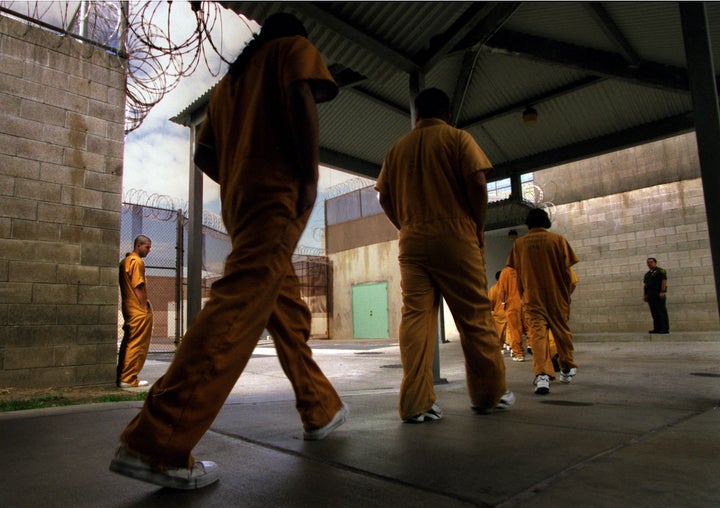
LOS ANGELES ― The U.S. Department of Justice’s civil investigation into a tainted jailhouse informant program in Orange County, California has officially begun.
For more than three years, the Orange County district attorney’s office and sheriff’s department have been embroiled in a sprawling jailhouse informant scandal ― one that may have involved the violation of numerous defendants’ civil rights, and that threatens to upend a number of already settled murder cases.
The DOJ is examining allegations of misconduct against county prosecutors and sheriff’s deputies accused of using jailhouse informants to gather incriminating statements from inmates in county jail and then covering it up. Deputies are accused of facilitating recorded and unrecorded conversations with inmates who were already represented by lawyers ― a violation of an inmate’s right to counsel. Prosecutors are alleged to have then used damning evidence gathered by jail informants and presented it in court to bolster their cases, while simultaneously withholding any evidence that could have been beneficial to the defendant, a move that violates the right to due process.
The DOJ announced an investigation into the scandal in December, during President Barack Obama’s final weeks in office. The Obama Justice Department made investigations into law enforcement misconduct a hallmark of the administration, but President Donald Trump’s DOJ appears to be taking a more hands-off approach to civil rights abuses. The shifting priorities have raised some concerns about the future of the Orange County investigation, but DOJ spokesman Mark Abueg told The Huffington Post the probe remains ongoing.
The misconduct allegations against both agencies are complex, varied and still unfolding. But one case in particular may represent the most egregious example to emerge from the county so far of the alleged misuse of informants and the concealment of related evidence. It’s also one that illustrates a “win-at-all-costs” culture inside the DA’s office, as well as the fraught nature of the informant program jail deputies have been running for years and that some legal experts have criticized loudly.
The Troubling Case Of Ricardo Salas
In 2002, Pedro “Tiger” Martin, an active member of one of Orange County’s oldest gangs, the “F-Troop,” was found in his bullet-riddled car bleeding from a fatal gunshot wound to the head.
Court records indicate that investigators struggled with uncooperative witnesses, a lack of key evidence and ultimately no suspect in the killing. For nearly three years the case went cold. But that changed in 2005 when Santa Ana Police Detective David Rondou ― a cop with a history of cutting deals with inmates and informants, as reports from OC Weekly’s R. Scott Moxley have detailed ― worked with a gang member who fingered Jesse “Jesus” Madrigal as the killer. Rondou told Madrigal that investigators had enough evidence already to charge him with murder, but knew he hadn’t acted alone. So faced with a possible life sentence, Rondou presented Madrigal with two options: tell them what happened during the shooting and who else was involved, or “hold that big bag of shit by yourself,” court records indicate.
Madrigal adamantly denied the accusations that he was the shooter, but eventually admitted to participating in the killing as the driver of the car that opened fire on Martin. He also said that two of his fellow gang members ― Juan Becerra and Ricardo Salas ―were the real shooters, and that Salas fired a shot right through Martin’s windshield.
Salas was arrested shortly after being named and was held without bail in county jail. From 2005 to 2007, he remained jailed in Orange County and had a series of cellmates, none of whom reported that Salas talked about his case. But that supposedly changed in June 2007, when a man named Landon Horning became his new cellmate. Horning would later claim Salas confessed to him about the Martin murder.

Horning did know information about Salas’ case and testify about it. But Tarik Adlai, Salas’ appellate lawyer, argues Salas didn’t get that information through a confession from Salas.
Instead, he says, Horning saw it in Salas’ papers. In mid-June, when Salas was called from his cell for court proceedings, Horning was left behind with Salas’ case documents, which included police reports, news articles about the killing, interview transcripts, Madrigal’s statement and other related information. Less than a week later, Horning wrote a letter to OCDA headquarters telling them that he had “some information for the District Attorney,” that it was “important,” and requested that “someone to come and see me.”
Horning then told law enforcement he’d obtained a detailed confession from Salas that he was one of the key shooters in the Martin killing.
Hidden Evidence About The Informant’s Credibility And Mental Illness Emerges 10 Years Later
Adlai questions the entire premise that his client Salas, a Hispanic gang member, would have ever confided in Horning, a white inmate whom he hardly knew. The whole act would have been “highly unusual and presumptively improbable,” he said.
Horning maintains that he simply struck up a conversation with Salas, who he said “likes to talk” ― despite Salas not having spoken to anyone in jail about his case for nearly two years ― and felt compelled to give up the information to law enforcement out of a sense of moral duty.
Prosecutors argue that Horning was placed in Salas’ cell by chance and that he was not working for them as an informant at the time. But Adlai argues that moving Horning into Salas’ cell was done on purpose. He says that prosecutors and police placed Horning into Salas’ cell with the explicit intent of coercing Salas into sharing damning information so it could be used against him in court. But Salas already had legal representation, so if the allegations are true, this would be a clear violation of Salas’ rights.
During Salas’ 2007 trial, prosecutors put Horning on the stand to testify about his conversation with his former cellmate. It was then that some odd inconsistencies in Horning’s story surfaced, according to Adlai.
First, Horning said Salas went by his formal birth name “Ricardo.” This is the name used in the court papers Horning had access to in his cell with Salas, but Salas was in fact known to go by “Ricky.” Horning also referred to Madrigal as “Jesus.” Again, this was the name used in court documents, but the name he was better known by was “Jesse.” Then, perhaps most perplexing of all, Horning told the jury that Salas confessed to him that he was riding in the front passenger seat of the El Camino that Madrigal was driving, while the other alleged shooter sat in the back seat. However, according to court records, Madrigal’s car did not have a back seat, something Salas of course would have known.
Beyond the questions about the alleged confession itself, Adlai has found a trove of records not originally disclosed to the defense that reveal Horning’s disturbing mental health history and suggest a cover-up by prosecutors and sheriff’s deputies in order not to jeopardize their conviction of Salas.
During his testimony, Horning said he was currently taking anti-inflammatory medication. And while he also said he took antidepressants while in custody, Adlai later discovered through Horning’s medical records, which he obtained post-trial, that Horning was not taking anti-inflammatory meds; rather, he was being “medicated with anti-psychotics.”
Adlai also unearthed information in the sheriff’s decades-long concealed internal database tracking inmates and informants that were not produced to Salas’ defense team until 2016. Those records indicate that Horning had a “mental/suicidal history” and had “attempted suicide by hanging himself” in the past, that he “hears voices and … [is] schizo, obsessive-compulsive, and paranoid.” He also had a history of lying to jail staff to receive favorable treatment, and once obtained a release to a hospital by pretending to be blind and deaf. Also unbeknownst to Salas’ defense, Horning had suffered permanent brain damage as the result of a car accident.

Although unknown to the defense at the time of the trial, Horning had also struggled with serious substance abuse issues. Citing newly discovered medical records, Adlai alleges that Horning had a history of “doctor-shopping to get opiates from multiple doctors,” and telling “incredible” lies to obtain prescription drugs and smuggling drugs into jail “by stuffing them in his anal canal.”
“Although the prosecution knew of Horning’s brain damage, drug addiction and mental illness, it never disclosed that information,” Adlai writes.
Allegations That OCDA Hid Horning From The Defense And Doctored His File
Not only did prosecutors fail to turn over key records before trial, Adlai alleges that before Salas’ trial even began, Horning was being kept hidden from Salas’ defense by prosecutors and law enforcement so he could not be interviewed.
Before Salas’ trial, Horning was released from jail early and moved from Orange County to Chico, more than 500 miles north of the county. According to files maintained by OCDA, prosecutors obtained permission to release Horning early and move him, claiming it was necessary for “safety reasons” due to Salas being a known gang member. But according to a report produced by Detective Rondou, Horning never cited safety and simply said he wanted to be rewarded for any informant work he did and “leave Orange County and reside with his wife” in Chico.
Citing previously undisclosed probation records of Horning’s that Adlai obtained, Deputy District Attorney Allison Gyves and former DA Investigator Robert Erickson sought permission for Horning to serve out his probation in Northern California, but probation officials initially denied that request. Erickson, though, would later call Horning’s probation officer directly and, rather than mentioning safety as a concern, explain that the reason for the move was that the “defense may have info to contact in O.C. but not in Chico, Prosecuting D.A. willing to write letter requesting [Horning] be allowed to move to Chico.” Probation officials received that letter from Gyves that same day and approved her request, and Horning was released about a month early. The DA’s office also agreed to make Horning’s travel arrangements to Chico, and later he was “flown in” for Salas’ trial.
Adlai argues that the prosecution team released Horning early from jail and then had him secreted out of Orange County and into Chico, not for safety reasons but so that the defense could not interview Horning before the trial began. He also says the transportation arrangements made for Horning amount to benefits received for his informant work in the case. Adlai says that documentation and benefits were never disclosed to the defense at the time of Salas’ trial.
Further, Assistant Public Defender Scott Sanders, who for years has been surfacing damning evidence about the illegal activity inside the county’s jailhouse informant program, examined documentation that the OCDA only recently disclosed to the defense, and argues that its contents indicate more deception. In a 2016 brief in a separate murder case, Sanders included copies of the record the DA’s office kept on Horning as part of the Orange County Informant Index case files the agency maintains for informants used throughout the county.
Sanders says entries on Horning’s index card appear to have been fraudulently dated to make them look written contemporaneously with the events they describe.

The front of the two-sided card has a submission date of Sept. 28, 2007, indicating this was when it was first created. However, the back of the card has entries describing details of what took place with the informant beginning on Aug. 14, 2007 ― more than a month before the card was even created ― indicating the entries were misleadingly written well after the dates listed.
Sanders also suggests that the two entries emphasizing that Horning was moved for safety reasons ― recently shown to be false by Horning’s probation records ― were likely generated to mislead the defense. Additionally, according to Sanders, the writing style and handwriting on three consecutive entries allegedly spanning a month appear “to be from the same pen” and written on the same date.
Sanders says the index card is “immensely concerning” and represents more “evidence of a culture in which deception has been occurring with seeming regularity.”
In a brief filed at the end of 2016, OCDA denied again that Horning was working for them as an informant in this case and said that the damning information he claims to have obtained from Salas was just coincidence. They also argue that that Horning’s move into Salas’ cell was happenstance, that they did not conceal any information about Horning’s medical condition, did not move to release Horning early to hide him from the defense and did not hide that Horning received benefits for his work in the case.
Based upon the allegations of prosecutor and deputy misconduct, Salas is currently seeking a new trial.
The Jailhouse Informant Scandal Continues To Unfold
Salas’ case is one of many that have been tainted by the Orange County jailhouse informant scandal. The scandal has already led to multiple murder cases in the county unraveling, with some accused murderers even having their sentences vacated.
It began to reach critical mass in mid-2014, when Superior Court Judge Thomas Goethals permitted a second round of hearings regarding jailhouse informant evidence in the case of Scott Dekraai, a man who shot and killed eight people in 2011 in the deadliest mass murder in Orange County history. Sanders is Dekraai’s attorney.
Goethals’ decision came after Sanders discovered that the county sheriff’s department had been documenting the movements of jail inmates and informants for at least two decades ― but had kept those records concealed.
The records showed that at least two sheriff’s deputies had “either intentionally lied or willfully withheld information” from the court during the Dekraai proceedings, Goethals said in a ruling. The judge also admonished the district attorney’s office for failing to turn over the computerized records after almost two years, despite repeated court orders to produce them. Even if this was unintentional, the judge ruled, it was still a “serious discovery violation.”
The deception was so significant that in early 2015, Goethals booted the entire district attorney’s office from the remaining proceedings in the Dekraai case. Goethals’ ruling was affirmed last year by California’s 4th District Court of Appeal, which concluded that the “magnitude” of “systemic problems” in county’s jail informant program “cannot be overlooked.”
Another bombshell came in early 2016, when a 1,157-page secret database surfaced. The database, which described years’ worth of interactions with inmates and informants, shed new light on the scope of the informant program in the county.
Once this database was discovered, the district attorney’s office finally acknowledged ― after years of denials ― that an informant program does indeed exist, and sheriff’s deputies had actively “recruited and utilized” informants and rewarded them in exchange for information.
The DA’s office also admitted that the log contradicts statements made by multiple witnesses, including several members of law enforcement in the county, who’d testified during hearings in the Dekraai case.
Meanwhile, the sheriff’s department continues to deny that a formal jail informant program exists ― despite evidence to the contrary, like the log itself, newly discovered internal OCSD memos stretching back more than a decade describing informant use, and an official OCSD handbook describing the informant program. But Goethals emphatically rebuked OC Sheriff Sandra Hutchens in court last month, saying unequivocally that a jail informant program exists in the county and that “debate is over.”
Goethals also called for new evidentiary hearings in the case, in part due to the appearance of intentional manipulation and/or destruction of many entries in the special handling log and allegations that the sheriff has still not turned over all documents related to the informant program.
OC District Attorney Tony Rackauckas has maintained that no one in his office intentionally behaved inappropriately in relation to the jailhouse informant program. OCSD argues similarly and that it has taken steps to create more robust ways of documenting and managing inmates.
It remains unclear exactly how many cases in the county may have been affected by tainted informant evidence, but Sanders has argued that every case involving a jailhouse informant in Orange County over the last 30 years deserves to be re-examined.
